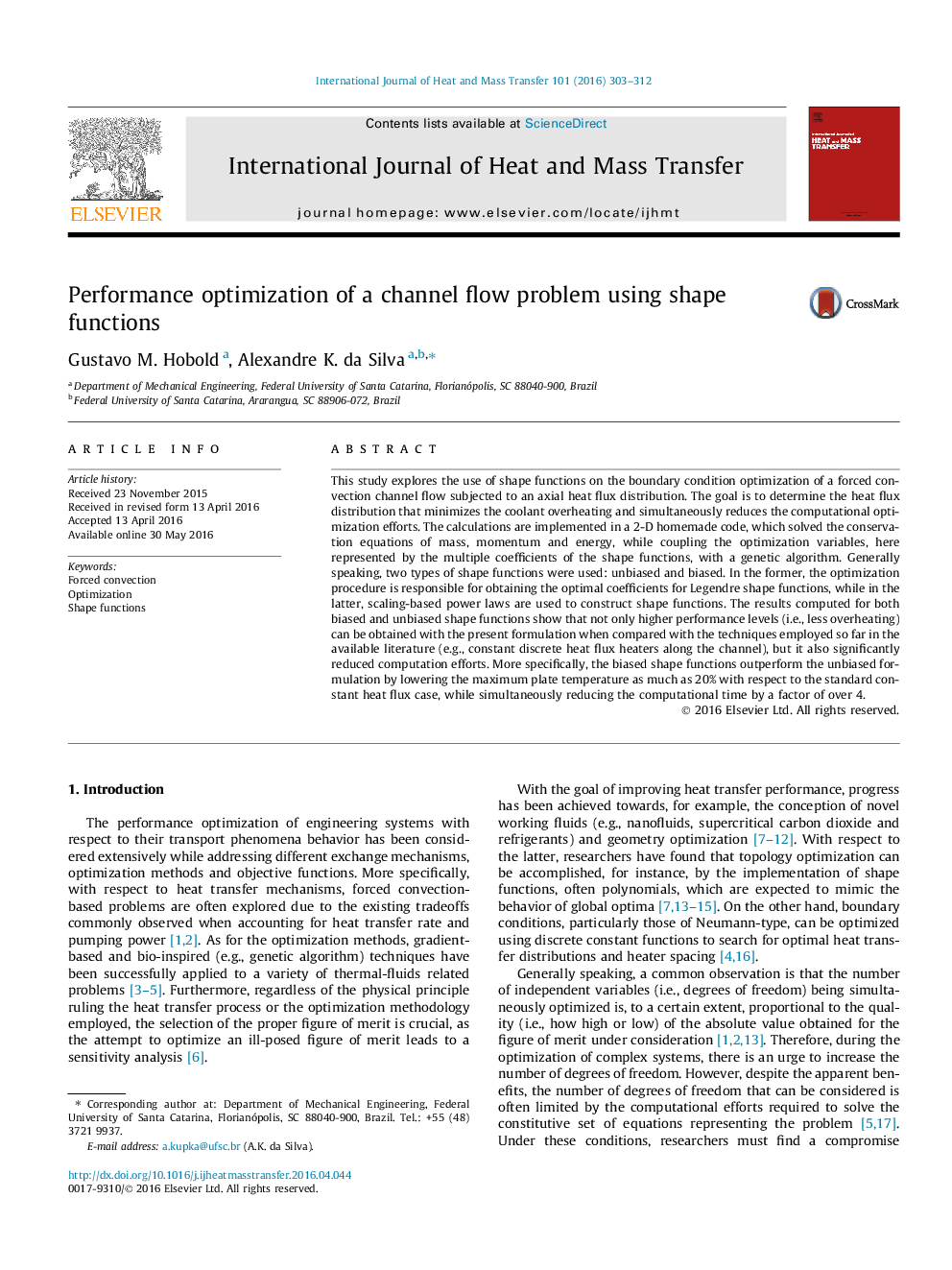| کد مقاله | کد نشریه | سال انتشار | مقاله انگلیسی | نسخه تمام متن |
|---|---|---|---|---|
| 7055228 | 1458041 | 2016 | 10 صفحه PDF | دانلود رایگان |
عنوان انگلیسی مقاله ISI
Performance optimization of a channel flow problem using shape functions
ترجمه فارسی عنوان
بهینه سازی عملکرد یک مشکل جریان کانال با استفاده از توابع شکل
دانلود مقاله + سفارش ترجمه
دانلود مقاله ISI انگلیسی
رایگان برای ایرانیان
کلمات کلیدی
کنسانتره اجباری، بهینه سازی، توابع شکل،
ترجمه چکیده
این مطالعه به بررسی کاربرد توابع شکل در شرایط بهینه سازی مرز یک جریان کانال مجاور اجباری تحت توزیع شار حرارتی محوری می پردازد. هدف این است که توزیع شار حرارتی را تعیین کنید که به حداقل رساندن بیش از حد خنک کننده و به طور همزمان تلاشهای بهینه سازی محاسباتی را کاهش دهد. محاسبات در یک کد خانگی دوبعدی اجرا می شود که معادلات حفاظت از جرم، حرکت و انرژی را حل می کند، در حالیکه متغیرهای بهینه سازی را با استفاده از ضرایب چندگانه توابع شکل با یک الگوریتم ژنتیکی مرتبط می کند. به طور کلی، دو نوع توابع شکل مورد استفاده قرار گرفت: بی طرف و بی طرف. در مرحله اول، روش بهینه سازی مسئول دریافت ضرایب بهینه برای توابع شکل لژاندر است، در حالی که در آخر، قوانین قدرت مبتنی بر پوسته پوسته شدن برای ساخت توابع شکل مورد استفاده قرار می گیرند. نتایج محاسبه شده برای هر دو عملکرد بی نظیر و بی طرفانه نشان می دهد که نه تنها سطوح عملکرد بالاتر (به عنوان مثال، بیش از حد گرم شدن) می تواند با فرمول فعلی در مقایسه با تکنیک های مورد استفاده در حال حاضر در ادبیات در دسترس (به عنوان مثال، در طول کانال)، اما همچنین به طور قابل توجهی تلاش های محاسباتی را کاهش داد. به طور خاص، توابع شکل متعصبی از فرمول بی طرفی با پایین آوردن حداکثر دمای صفحات تا 20٪ در مورد شار گرما ثابت ثابت استفاده می کنند، در حالی که به طور همزمان زمان محاسبات را با یک عامل بیش از 4 کاهش می دهد.
موضوعات مرتبط
مهندسی و علوم پایه
مهندسی شیمی
جریان سیال و فرایندهای انتقال
چکیده انگلیسی
This study explores the use of shape functions on the boundary condition optimization of a forced convection channel flow subjected to an axial heat flux distribution. The goal is to determine the heat flux distribution that minimizes the coolant overheating and simultaneously reduces the computational optimization efforts. The calculations are implemented in a 2-D homemade code, which solved the conservation equations of mass, momentum and energy, while coupling the optimization variables, here represented by the multiple coefficients of the shape functions, with a genetic algorithm. Generally speaking, two types of shape functions were used: unbiased and biased. In the former, the optimization procedure is responsible for obtaining the optimal coefficients for Legendre shape functions, while in the latter, scaling-based power laws are used to construct shape functions. The results computed for both biased and unbiased shape functions show that not only higher performance levels (i.e., less overheating) can be obtained with the present formulation when compared with the techniques employed so far in the available literature (e.g., constant discrete heat flux heaters along the channel), but it also significantly reduced computation efforts. More specifically, the biased shape functions outperform the unbiased formulation by lowering the maximum plate temperature as much as 20% with respect to the standard constant heat flux case, while simultaneously reducing the computational time by a factor of over 4.
ناشر
Database: Elsevier - ScienceDirect (ساینس دایرکت)
Journal: International Journal of Heat and Mass Transfer - Volume 101, October 2016, Pages 303-312
Journal: International Journal of Heat and Mass Transfer - Volume 101, October 2016, Pages 303-312
نویسندگان
Gustavo M. Hobold, Alexandre K. da Silva,
